

'Webrooming' Trumps Showrooming: Three Ways Brands, Retailers Can Win. There’s a dichotomy to the “always on, always connected” way of life created by digital and mobile devices today.
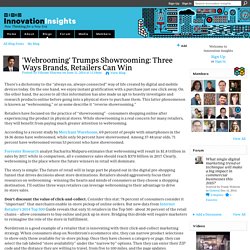
On the one hand, we enjoy instant gratification with a purchase just one click away. On the other hand, the access to all this information has also made us apt to heavily investigate and research products online before going into a physical store to purchase them. This latter phenomenon is known as “webrooming,” or as some describe it “reverse showrooming.” Retailers have focused on the practice of “showrooming” - consumers shopping online after experiencing the product in physical stores. While showrooming is a real concern for many retailers, they will benefit from paying much greater attention to webrooming. According to a recent study by Merchant Warehouse, 69 percent of people with smartphones in the 18-36 demo have webroomed, while only 50 percent have showroomed. Can web technology help to save the high street? Bill Grimsey, who we interviewed on this blog, presented his Alternative Future for the High Street review to ministers and business leaders at parliament yesterday.
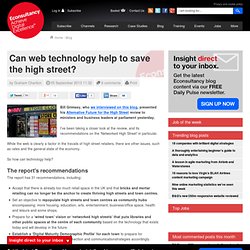
I've been taking a closer look at the review, and its recommendations on the 'Networked High Street' in particular. While the web is clearly a factor in the travails of high street retailers, there are other issues, such as rates and the general state of the economy. Radio 4 Woman's Hour -Mary Portas - Queen of Shops. IBM's Watson Could Be Your Next Shopping Partner. Imagine having IBM’s artificially intelligent robot, Watson -- the same robot that made even the smartest of us feel like bumbling fools on Jeopardy -- help you decide on just what pair of heels to buy.
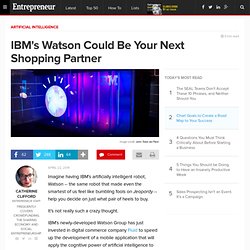
It’s not really such a crazy thought. IBM’s newly-developed Watson Group has just invested in digital commerce company Fluid to speed up the development of a mobile application that will apply the cognitive power of artificial intelligence to e-commerce. In addition to the cash infusion, the Fluid team will gain access to the IBM Watson development platform in the cloud. Financial terms of the deal were not disclosed. “By tapping into IBM Watson’s cognitive intelligence, Fluid is infusing the personalized, interactive feel of an in-store conversation into every digital shopping interaction,” said Mike Rhodin, a senior vice president at IBM’s Watson Group, in a statement. Commerce is at a tipping point, so how can retailers stay relevant? Over the past five years global e-commerce has experienced tremendous growth.
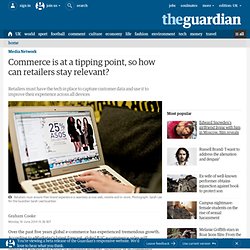
According to eMarketer's latest forecast, global B2C e-commerce sales will increase by 20.1% this year to reach $1.5tn thanks to the rapid expansion of online and mobile user bases in emerging markets, increases in m-commerce sales, better shipping and payment options, as well as major brands entering new, international markets. Furthermore, recent reports from Deloitte have confirmed that 50% of all in-store sales will be influenced by digital services by the end of 2014, with in-store conversion rates being 13% higher when shoppers use their digital devices to research products and services online. These stats are cast-iron proof that we're at a tipping point and retailers who are still figuring out their digital offering need to step up before it's too late. But how? Leveraging online data Web behavioural data is set to become the key currency for commerce. Delivering a consistent brand experience.
It’s personal: how technology will change the way we shop. The dramatic progress we’ve seen over the past three years in the world of technology is starting to have material effects on the ways customers experience retail.
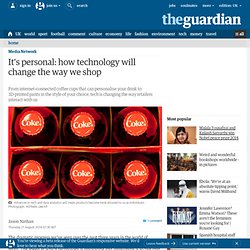
The speed at which technology is innovating and developing is so fast that many of today’s fringe ideas could well become mainstream. There are four technology trends in particular that will fundamentally drive these changes to retail and they’re all centred around personalisation: data science, the internet of things, the back office and personal production. Data science Increasing volumes of data and improved techniques to hold, merge and act upon that data in real-time is driving personalisation via the more traditional marketing levers: price, promotions, product and place. Meet the shop assistant of the future. The role of the customer assistant is changing dramatically.

Gone are the days when all you needed was a winning smile, helpfulness and the ability to operate a low-tech till to satisfy customer needs. Today, with bricks and mortar stores embracing new technology in order to compete with online outlets, digital skills are becoming increasingly critical for the shop assistant. How to replicate the impulse buy online. Online retailing performs well in terms of price and ability to offer anywhere and anytime shopping, but the channel can sometimes struggle to recreate the sudden temptation and instant gratification that characterise the impulse buy.

By bringing together the availability of online with the immediacy of the high street, it is becoming possible thanks to omni-channel strategies that link the different shopping channels. Impulse purchases are a familiar aspect of bricks and mortar shopping; inspiring shoppers and encouraging them to consider new products is part of what good retailers do best. It ensures loyal customers keep returning and hooks in new customers who may have just come in for a browse. But the way we shop is changing. New technologies and shifting consumer habits are making impulse shopping possible at home and on the move, as well as in stores. Impulse shopping, however, is more complex than the name suggests. 1.
Publications also offer another point of contact. Why the Future of Retail Will Blow Your Mind. Join us in a city near you at Entrepreneur’s Accelerate Your Business event series kicking off Feb 23.
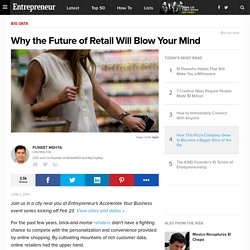
View cities and dates » For the past few years, brick-and-mortar retailers didn’t have a fighting chance to compete with the personalization and convenience provided by online shopping. By cultivating mountains of rich customer data, online retailers had the upper hand. Every action and inaction -- from what customers clicked on and how much time they spent looking at certain products to their social activity and response to email programs – helped online retailers tailor each email, pop-up or recommended product to drive sales and provide a superior experience.
For consumers, it was a welcome reprieve from the antiquated task of visiting a store, being treated as a stranger and receiving often-questionable customer service. This new customer journey had new engagement touch points across marketing, sales and service, and traditional retailers struggled to keep up. 1. Plastc Wants to Replace Your Wallet with a Single Card. Dedicated to replacing your wallet with a single card, Plastc brings all your credit and debit cards as well as your gift and loyalty cards (up to 20) into one sophisticated device.

With a magnetic stripe and barcode display, Plastc Card’s e-ink touchscreen gives you easy access to all your cards and works practically anywhere your current cards are accepted. In regards to fraudulent activity, the card’s magnetic stripe and NFC chip are disabled until you select your payment method. PIN entry acts as the first line of security; the card requires you to enter your PIN via the card’s e-ink touchscreen before selecting which form of payment you want to use.
Welcome to Forbes. Creating effective in-store digital retail experiences. As retailers figure out how to incorporate the ever-changing omnichannel and added extra credit card processing security, they will also need to think about the Internet of Things [IOT] and how it fits into the retail experience and marketing budget.
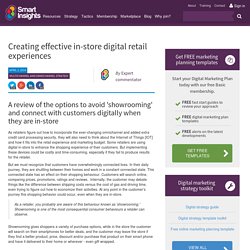
Some retailers are using digital in-store to enhance the shopping experience of their customers. But implementing these devices could be costly and time-consuming, especially if they fail to produce results for the retailer. But we must recognize that customers have overwhelmingly connected lives. In their daily journey, they are shuttling between their homes and work in a constant connected state. This connected state has an effect on their shopping behaviour. Creating effective in-store digital retail experiences.